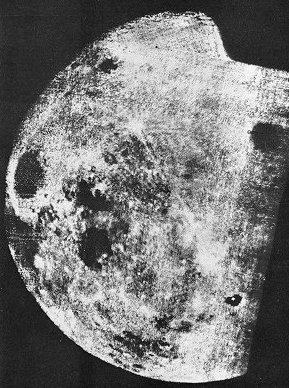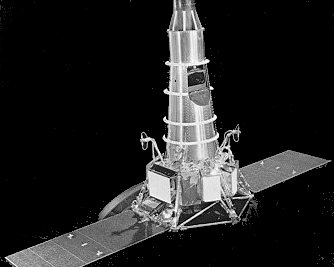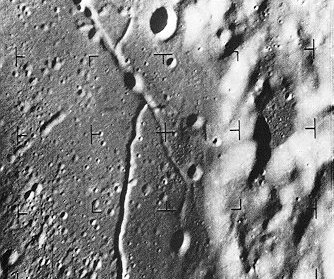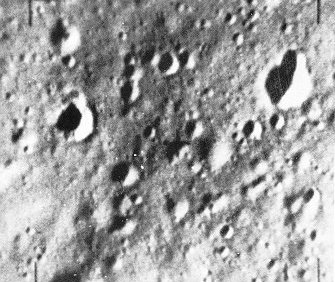Apollo Expeditions to the Moon
A SHAKY START
The military rockets developed in the 1950s provided a basic tool with which it
became possible to send rudimentary spacecraft to the Moon. Both the Army and the
Air Force were quick to initiate efforts to be the first to the Moon with a manmade
object. (The Russians, as it proved, were equally quick, or quicker.) These first U.S.
projects, which were transferred in 1958 to the newly formed National Aeronautics and
Space Administration, consisted of four Air Force Thor-Able rockets, and two Army
Juno II rockets, each with tiny payloads, designed to measure radiation and magnetic
fields near the Moon and, in some cases, to obtain rudimentary pictures. NASA and
the Air Force then added three Atlas-Abie rockets, which could carry heavier payloads,
in an attempt to bolster these early high-risk efforts. Of these nine early missions
launched between August 1958 and December 1960, none really succeeded. Two
Thor-Able and all three Atlas-Able vehicles were destroyed during launch. One Thor-Able
and one of the Juno II's did not attain sufficient velocity to reach the Moon and
fell back to Earth. Two rockets were left.

|
Mankind's first glimpse of the far side of the Moon came
in October 1959, provided by the Soviet spacecraft Luna
3. Although crude compared with later views, its pictures
showed a number of lunar features for the first time. One
of these was the crater Tsiolkovsky, named for the famed
Russian mathematician, which appears here in the lower
right as a small sea with an island in it. The images from
Luna 3 indicated that the Moon's far side lacked the large
mare areas an the side facing Earth.
|
The Soviets were also having problems. But on January 4, 1959, Luna 1, the first
space vehicle to reach escape velocity, passed the Moon within about 3700 miles and
went into orbit about the Sun. Two months later the United States repeated the feat
with the last Juno II, although its miss distance was 37,300 miles. A year later the last
Thor-Able payload flew past the Moon, but like its predecessors it yielded no new information
about the surface. On October 7, 1959, the Soviet Luna 3 became the first
spacecraft to photograph another celestial body, radioing to Earth crude pictures of the
previously unseen far side of the Moon. The Moon was not a "billboard in the sky"
with slatted back and props. Its far side was found to be cratered, as might be expected,
but unlike the front there were no large mare basins. The primitive imagery that Luna
3 returned was the first milepost in automated scientific exploration of other celestial
bodies.

|
A sophisticated craft for its day, the
800-lb Ranger or its launch vehicle
failed in its first six tries. Then it behaved beautifully, returning thousands
of pictures in its last three flights, most
of them far superior to the best that
could be obtained from telescopes on
Earth. Rangers crashed on the Moon at
nonsurvivable velocity; their work was
done in the few short moments from
camera turn-on to impact.
|

|
Heading in toward Alphonsus, a
lunar crater of high scientific interest,
Ranger IX sent back 5814 pictures of
the surface before it crashed. The one
at left, taken several score miles away,
shows part of the crater floor and
slumped wall of Alphonsus, a rille
structure, and a varied population of
craters. Ranger pictures were exciting
in the wholly new details of the Moon
that they provided.
|

|
The last instant before it srnashed,
Ranger IX radioed back this historic
image, taken at a spacecraft altitude
of one-third mile about a quarter of a
second before impact. The area pictured is about 200 by 240 feet, and
details about one foot in size are
shown. The Ranger pictures revealed
nothing that discouraged Apollo planners, although they did indicate that
choosing an ideally smooth site for a
manned landing was not going to be an
easy task.
|
Undaunted by initial failures, and certainly spurred on by Soviet efforts, a NASA
team began to plan a long-term program of lunar exploration that would embody all
necessary ingredients for success. The National Academy of Sciences was enlisted to
help draw the university community into the effort. The Jet Propulsion Laboratory, a
California Institute of Technology affiliate that had been transferred from the Army
to NASA in 1958, was selected to carry out the program. JPL was already experienced
in rocketry and had participated in the Explorer and Pioneer IV projects.
|




